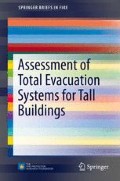Abstract
The method employed in this study is the application of evacuation modelling techniques. The initial phase of the study is therefore the selection of the appropriate egress models to simulate the total evacuation of high-rise buildings. In particular, the model case study includes the simulation of a combined use of egress components such as stairs and elevators. A recent review (Ronchi and Nilsson 2013b) identified two models having different modelling approaches that are suitable for testing the effectiveness of egress strategies in high-rise buildings. These models are Pathfinder (Thunderhead Engineering 2012) (a continuous model) and STEPS (Mott MacDonald Simulation Group 2012) (a fine network model).
Access this chapter
Tax calculation will be finalised at checkout
Purchases are for personal use only
References
Gwynne SMV, Kuligowski E (2010) The faults with default. In Proceedings of the 12th Conference Interflam2010, Interscience Communications Ltd, London, pp 1473–1478
Lord J, Meacham B, Moore A, Fahy R, Proulx G (2005) Guide for evaluating the predictive capabilities of computer egress models, NIST Report GCR 06-886
Mott MacDonald Simulation Group (2012) Simulation of Transient Evacuation and Pedestrian movementS STEPS User Manual 5.1 Version
Ronchi E (2012) Evacuation modelling in road tunnel fires. Phd Dissertation. Polytechnic University of Bari, Italy
Ronchi E, Nilsson D (2013b) Fire evacuation in high-rise buildings: a review of human behaviour and modelling research. Fire Science Rev 2:7. doi:10.1186/2193-0414-2-7
Ronchi E, Nilsson D, Gwynne SMV (2012a) Modelling the impact of emergency exit signs in tunnels. Fire Technol 48(4):961–988. doi:10.1007/s10694-012-0256-y
Ronchi E, Gwynne SMV, Purser DA, Colonna P (2012b) Representation of the impact of smoke on agent walking speeds. Fire Technol, In Press doi: 10.1007/s10694-012-0280-y
Thunderhead Engineering (2012) Pathfinder 2012.1.10802 Version. Technical Reference
Author information
Authors and Affiliations
Rights and permissions
Copyright information
© 2014 Fire Protection Research Foundation
About this chapter
Cite this chapter
Ronchi, E., Nilsson, D. (2014). Method. In: Assessment of Total Evacuation Systems for Tall Buildings. SpringerBriefs in Fire. Springer, New York, NY. https://doi.org/10.1007/978-1-4939-1074-8_2
Download citation
DOI: https://doi.org/10.1007/978-1-4939-1074-8_2
Published:
Publisher Name: Springer, New York, NY
Print ISBN: 978-1-4939-1073-1
Online ISBN: 978-1-4939-1074-8
eBook Packages: Computer ScienceComputer Science (R0)

